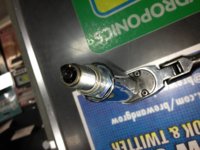theblackassassin
XS650 Addict
So i was riding with my friend last night and he noted i had some white smoke puffs coming out on deceleration of my bike left cylinder exhaust.
Nothing crazy just small puff amounts.
I have had no problems with my plugs being fouled etc.
Bike starts everyday
The engine i have in is My XS2 engine and was recently rebuilt by myself and i made sure to change out all the seals and gaskets and everything out of spec.
So valve guide seals were replaced.
The rings were not out of spec but replaced anyways.
I did not change the guides because they were up to spec.
I did everything by the clymer book
So i have an XS2 motor with bs34 carbs on that motor.
The motor has been in for 3 weeks now.
Running great.
Compression great
The bs34 carbs were actually rebuilt about 6 months ago from a shop in the city when they were on my 1980 motor.
That being said it also throws out some smoke on throttle blips same cylinder.
I looked in there today and noticed wetness. I tried smelling it but my nostrils are shot right now.
I am under the impression my float height may be a little off on that carb.
Though i am looking for some other opinions.
i haven't got home yet to see what my float height is on that carb so i will be checking tonight.
Just looking to see what ya guys think.
Nothing crazy just small puff amounts.
I have had no problems with my plugs being fouled etc.
Bike starts everyday
The engine i have in is My XS2 engine and was recently rebuilt by myself and i made sure to change out all the seals and gaskets and everything out of spec.
So valve guide seals were replaced.
The rings were not out of spec but replaced anyways.
I did not change the guides because they were up to spec.
I did everything by the clymer book
So i have an XS2 motor with bs34 carbs on that motor.
The motor has been in for 3 weeks now.
Running great.
Compression great
The bs34 carbs were actually rebuilt about 6 months ago from a shop in the city when they were on my 1980 motor.
That being said it also throws out some smoke on throttle blips same cylinder.
I looked in there today and noticed wetness. I tried smelling it but my nostrils are shot right now.
I am under the impression my float height may be a little off on that carb.
Though i am looking for some other opinions.
i haven't got home yet to see what my float height is on that carb so i will be checking tonight.
Just looking to see what ya guys think.


